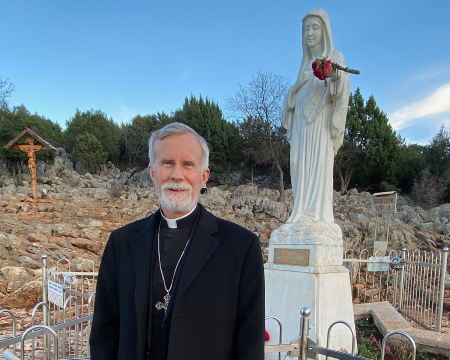We ask you, humbly: don't scroll away.
Hi readers, it seems you use Catholic Online a lot; that's great! It's a little awkward to ask, but we need your help. If you have already donated, we sincerely thank you. We're not salespeople, but we depend on donations averaging $14.76 and fewer than 1% of readers give. If you donate just $5.00, the price of your coffee, Catholic Online School could keep thriving. Thank you.Help Now >
Raphoe
FREE Catholic Classes
Diocese of Raphoe (Rapotensis)
Comprises the greater part of the Co. Donegal (Gael. Tirconail ), in the ecclesiastical province of Armagh. Raphoe (Gaelic, Rathboth , fort of cottages) was the first of St. Columba's Irish foundation to become as episcopal see. The monastery which he founded there in the sixth century was renovated about the year 700 by Adamnan, who succeeded him in Raphoe as well as in Iona. Although Adamnan died in Iona (704) he spent the last six years of his life in Ireland, and his mother's kindred were the clan that occupied the Raphoe district. It is suggested that then, but not before, he may have been in episcopal orders with a sedes at Raphoe (Cuimhne Coluimcille, 12). Be that as it may, for Eunan, venerated as the first bishop of Raphoe, and so recorded by early Irish writers and the ancient calendars, is no other than Adamnan, whose name has the same pronunciation with Irish speakers. There is no record of a break in the line of Catholic succession in Raphoe. But from the death of Nial O' Boyle in 1610 to the appointment of James O'Gallagher in 1725, owing to the violence of persecution, the diocese was administered by vicars except during the episcopate of John O'Culenen from 1625 to 1661. The sufferings of this prelate were characteristic of the times. He was arrested, taken to Dublin, and twice brought before the viceroy and Privy Council. About 1643 he again fell into the hands of his enemies. Along with some prominent men of his diocese he was besieged by English soldiers and forced to surrender. Though promised quarter, seventy-two of his followers were put to the sword, and the bishop was given the choice between death by drowning and death at the hands of the military. Electing the latter fate he was stripped naked, and as the crossbows and matchlocks failed to discharge against the kneeling victim, pikemen were advancing to dispatch him, when Colonel Sir James Asken arrived upon the scene and prevented the murder, severely rebuking the soldiers. The bishop was then confined for four years in Derry in a dark dungeon where cold, hunger, and thirst were his portion. In the exchange of prisoners after Owen Roe O'Neill's victory at Benburg he regained his liberty in 1647. But when the remnant of the Irish army under Heber MacMahon was defeated near Letterkenny in 1650, O'Culenan's life was once more in daily peril. He made his way out of the country in 1653, and died at Brussels, 24 March, 1661. Six bothers, all older than himself, held high offices in the Church. The eldest, Gelasius, a doctor of the Sorbonne and Abbot of Boyle, was imprisoned in Dublin, tortured, and hanged. The next Bishop of Raphoe, whose appointment comes just a hundred years after that of O'Culenan, had also to fly for his life. In 1734 James O'Gallagher escaped capture by mounting a horse in the dead of night shortly before soldiers came to seize him. He sought refuge on a remote island in an Irish lake, and, during a year's concealment there, wrote for publication the Irish sermons which he had been accustomed to deliver to his flock, and which, when printed in 1736, became a powerful reminder of the duties of a Christian life throughout the western half of Ireland at a time of fierce aggression on the Faith. A marked man, he could not show himself again in Raphoe, and he was transferred to Kildare in 1737, where he found it needful to make a secluded spot in the Bog of Allen the centre of his apostolic labours.
Driven out at the Reformation, a Catholic bishop has never since resided at Raphoe. Even before the flight of the earls from Rathmullen (1607), Donald MacCongail, a remarkable prelate, who was present at the Council of Trent in 1563 and at the Ulster provincial Council in 1587, seems to have resided most of his time at Killybeg, on ground now occupied by structures connected with St. Columba's Marine Industrial School. A remnant of the ancient cathedral church in Raphoe still shows in the chancel of the Protestant cathedral there; but no ruin marks the site of the ancient monastery. It is different with the foundations at Gartan, Glencolumbkille and Kilmacrenen, associated with Columba. More striking to the eye are the remains of the remarkable abbeys founded during the Middle Ages in the Diocese of Raphoe. The Cistercians were at Assaroe, near Ballyshannon, the Carmelites at Rathmullen, the Franciscans in almost every district of Tirconail. The most celebrated of these foundations was the Franciscan abbey at Donnegal, under whose shelter, after it was dismantled, the "Annals of the Kingdoms of Ireland " were compiled by the Four Masters (1632-1636). After the plantation of Ulster in the seventeenth century not an acre of good land remained in the hands of a Catholic in Tirconill. To this day some of its confiscated abbey lands yield an annual income of £9000 sterling to the Trinity College, Dublin.
Dr. Patrick McGettingen (1820-1861) brought the Loreto Sisters to the Diocese of Raphoe (1854); Dr, Daniel McGettingen (1861-1871), afterwards primate of all Ireland, introduced the Sisters of Mercy (1867), and Dr. James McDevitt (1971-1879) established the Raphoe Diocesan Society (1872); the Presentation Brothers came to Letterkenny in 1894. The year 1901 is an important date in the history of Raphoe; it was then that the ancient cathedral - chapter was re-established by Leo XIII and St. Columba declared joint patron with St. Eunan of the diocese and of the new cathedral. In that year also the new cathedral, with which the bishop's residence is at Letterkenny, was solemnly dedicated. Cardinal Logue, a native and former bishop (1879-1897) of Raphoe, presided, and Archbishop Keane of Dubuque, also a native, preached the dedication sermon. St. Eunan's (Adamnan's) College was begun at Letterkenny on 23 September 1904, the twelfth centenary of St. Adamnan, and opened in 1906. There are many pilgrimages in Raphoe, the most frequent being Doon Well, Inniskeel, St. Catherine's Well, and Glencolumbkille.
We ask you, humbly: don't scroll away.
Hi readers, it seems you use Catholic Online a lot; that's great! It's a little awkward to ask, but we need your help. If you have already donated, we sincerely thank you. We're not salespeople, but we depend on donations averaging $14.76 and fewer than 1% of readers give. If you donate just $5.00, the price of your coffee, Catholic Online School could keep thriving. Thank you.Help Now >








 Daily Readings for Sunday, April 21, 2024
Daily Readings for Sunday, April 21, 2024 St. Anselm: Saint of the Day for Sunday, April 21, 2024
St. Anselm: Saint of the Day for Sunday, April 21, 2024 A Prayer for the Dying and a Special Soul: Prayer of the Day for Sunday, April 21, 2024
A Prayer for the Dying and a Special Soul: Prayer of the Day for Sunday, April 21, 2024


